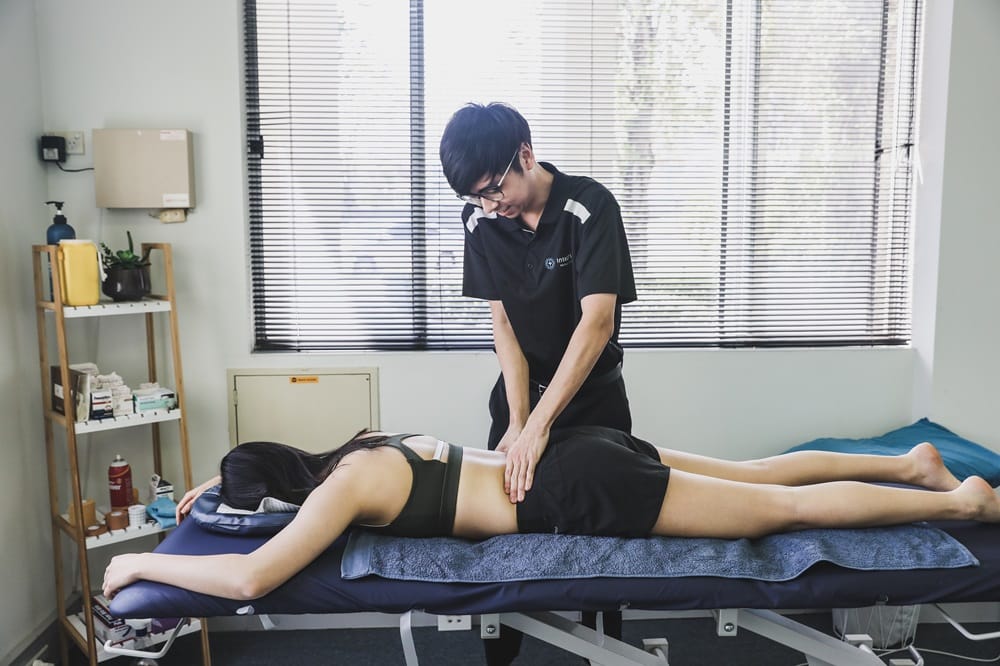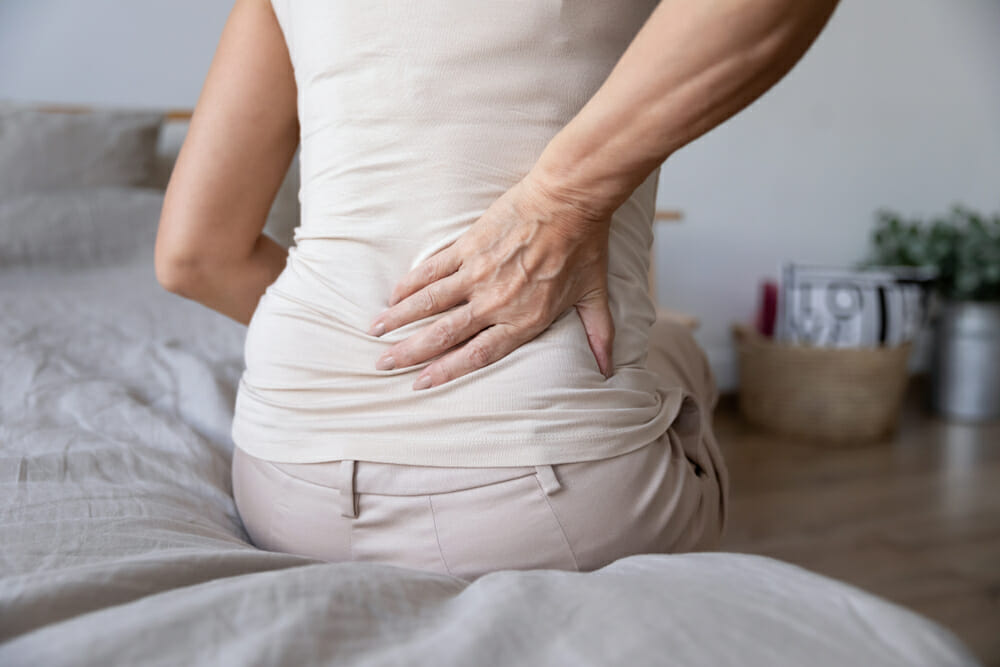
Most people will experience back pain at some point in their life. From the office worker hunched over a desk to the athlete pushing their physical limits, virtually no one is immune to this common problem.
With a variety of causes, ranging from lifestyle choices to medical conditions, back pain can be debilitating, affecting both physical and mental well-being.
Understanding the root cause of your back pain is essential for effective treatment. Without proper diagnosis, you may engage in treatments that are not only ineffective but potentially harmful. Chronic back pain can also take a toll on mental health, emphasising the need for effective strategies for relief.
If you’re in pain and looking for some back pain relief, read on to learn about common causes, symptoms, and ways to help you start feeling better.
Common causes of back pain
There are a range of back pain causes. From medical to lifestyle and everything else in between, finding the underlying cause is the first step in getting some relief.
Mechanical issues
Disc herniation
One of the most common causes of back pain is a herniated disc, also known as a slipped or ruptured disc. This occurs when the soft interior of an intervertebral disc protrudes through a crack in the tougher exterior. The herniated disc can then press on surrounding nerves, causing pain, numbness, or even weakness in an arm or leg.
Muscle or ligament strain
Repeated heavy lifting, sudden awkward movements, or chronic poor posture can strain back muscles and spinal ligaments. When you strain a muscle, it can cause spasms and discomfort, often leading to acute back pain that may become chronic if not addressed.
Medical conditions
Arthritis
Osteoarthritis can affect the lower back, leading to spinal stenosis, wherein the space around the spinal cord narrows, putting pressure on the nerves and causing pain. Rheumatoid arthritis, although less common in the back, can also cause discomfort.
Spinal stenosis
Spinal stenosis is characterised by the narrowing of spaces within the spine, which can put pressure on the spinal nerves, leading to pain or numbness when walking and affecting day-to-day activities.
Lifestyle factors
Poor posture
Poor posture is a leading cause of back pain, especially among people who work long hours at a desk or spend a lot of time looking down at their phones. Sitting or standing improperly can cause muscle tension and result in pain along the spine.
Sedentary lifestyle
A sedentary lifestyle can weaken back and core muscles, contributing to pain. Lack of exercise can lead to weight gain, putting additional stress on back muscles and ligaments, which exacerbates pain.
Other factors
Ageing
As we age, our bones and joints undergo natural wear and tear, known as degenerative changes. These changes can cause conditions like spinal stenosis, disc degeneration, or osteoarthritis, all of which may or may not result in back pain.
Accidents and injuries
Car accidents, falls, or athletic injuries can cause acute back pain. These types of injuries can result in fractures, sprains, or strains that lead to acute or even chronic back pain if not properly treated.
READ MORE: Back pain causes and symptoms
Types of back pain
When it comes to the type of back pain you’re experiencing, there are a few different things to keep in mind.
Is it acute vs. chronic pain?
- Acute pain: Acute back pain typically emerges suddenly and is often the result of a specific injury, strain, or trauma. This type of pain is usually short-lived and may resolve on its own with proper rest and conservative treatments.
- Chronic pain: Chronic back pain, on the other hand, persists for an extended period, usually exceeding three months. It can result from underlying medical conditions, degenerative changes in the spine, or ongoing musculoskeletal issues. Chronic back pain often requires a more comprehensive approach to management, involving medical intervention, physical therapy, and lifestyle adjustments.
Where is your back pain located?
Back pain can occur in various areas of the spine, each with distinct characteristics:
- Lower back pain (Lumbar): This is the most common type of back pain and often originates from muscle strains, ligament sprains, herniated discs, or degenerative changes in the lumbar spine. It can affect daily activities, good posture, and mobility.
READ MORE: Why does my lower back hurt? - Middle back pain (Thoracic): Middle back pain is less common than lower back pain. It might be caused by poor posture, muscle imbalances, or issues with the thoracic spine’s vertebrae and discs.
- Upper back pain (Cervical): Upper back pain typically stems from problems related to the cervical spine, which can include neck pain. It can be triggered by poor ergonomics, neck muscle strains, or conditions like cervical herniated discs.
READ MORE: Simple upper back stretches
Does the pain radiate?
Radiating pain is a type of back pain where discomfort extends beyond the primary affected area. Examples of conditions causing radiating pain include:
- Sciatica: sciatica results from compression or irritation of the sciatic nerve, often causing sharp, shooting pain that radiates down one leg. This condition can be linked to a herniated disc or spinal stenosis.
- Radicular Pain: sciatica being one example of this, radicular pain involves nerve compression or irritation, leading to pain, tingling, or numbness that travels along the affected nerve’s pathway.
- Referred Pain: referred pain occurs when pain in one area is perceived in a different location. For instance, a problem in your lower back could cause pain in the buttock or hamstring.
Natural remedies for back pain relief
Natural or home remedies for back pain relief encompass a wide range of techniques and practices that can help alleviate discomfort and improve overall back health. These approaches often prioritise non-invasive, holistic methods to address pain and promote healing.
Heat/cold therapy
Applying heat or cold to the affected area can provide immediate relief and reduce inflammation. Cold therapy (ice packs) can help numb the area and reduce swelling, while heat therapy (hot water baths or heating pads) can relax muscles and improve blood circulation.
Herbal remedies
Certain herbs have anti-inflammatory properties that can help alleviate back pain:
- Turmeric: curcumin, a compound in turmeric, has potent anti-inflammatory effects. It can be taken as a supplement or incorporated into meals.
- Willow bark: This natural pain reliever contains salicin, which is similar to the active ingredient in aspirin. It’s available in supplement form.
Massage and dry needling
These therapies aim to relieve tension and improve blood flow to the affected area. Massages can target specific muscles, while dry needling involves inserting thin needles into specific points on the body to promote healing and pain relief.
Exercises for back pain relief
Exercise is a cornerstone of not only general health but also in combating back pain. But it’s crucial to choose the right types of exercises that can alleviate, rather than exacerbate, your condition. Always consult your healthcare provider or a certified physiotherapist before starting a new exercise regimen. Look at incorporating some of these into your daily routine.
Stretching exercises
Cat-cow stretch
This yoga-inspired move is excellent for improving the flexibility and mobility of your spine.
- Start on all fours, aligning your hands under your shoulders and your knees under your hips.
- Inhale as you arch your back, dropping your belly towards the floor and lifting your head and tailbone towards the ceiling (this is the ‘Cow’ part).
- Exhale as you round your back, tucking in your chin and drawing your belly button towards your spine (this is the ‘Cat’ part).
- Repeat for 10-15 cycles.
Child’s pose
This simple but effective yoga pose can help relax your back muscles and relieve tension.
- Begin on all fours.
- Sit back on your heels while extending your arms forward on the mat.
- Lower your chest as you reach out, touching your forehead to the ground if possible.
- Hold for 20-30 seconds, focusing on deep breathing.
READ MORE: Foam roller exercises for thoracic mobility
Core-strengthening exercises
Planks
A strong core can provide better support for your back, which can alleviate back pain.
- Begin in a push-up position but with your weight on your forearms rather than your hands.
- Keep your body in a straight line from head to heels.
- Hold the position for as long as you can maintain good form, aiming for at least 30 seconds initially and building up over time.
Russian twists
This seated exercise targets your obliques, the muscles on the sides of your torso, improving your overall core strength.
- Sit on the ground with your knees bent.
- Lean back slightly and lift your feet off the ground, balancing on your sit bones.
- Hold your hands together in front of you.
- Twist your torso to the right, then to the left, to complete one rep.
- Perform 10-15 reps on each side.
Additional exercises
Bird-dog
This exercise improves balance and stabilizes the spine.
- Start on all fours.
- Extend your right arm and your left leg simultaneously, keeping them in line with your body.
- Hold for 5-10 seconds, then switch to the opposite arm and leg.
Bridging
This helps engage your glutes and lower back.
- Lie on your back with your knees bent and feet flat on the ground.
- Press through your heels and lift your hips towards the ceiling.
- Hold for 5-10 seconds before lowering back down.
- Repeat 10-15 times.
Yoga and pilates
Yoga and Pilates focus on mindfulness, flexibility, and core strength. These disciplines offer a variety of poses and exercises that can improve posture, relieve muscle tension, and enhance overall spinal health.
Medical treatments for back pain relief
Pain medications
For more severe cases, medical interventions may be necessary:
- Over-the-counter medication: Non-steroidal anti-inflammatory drugs (NSAIDs) like ibuprofen can help reduce pain and inflammation.
- Prescription medication: Muscle relaxants or opioid painkillers may be prescribed in cases where over-the-counter medications are insufficient.
Surgical options and interventional treatments
For individuals with severe, persistent pain or underlying structural issues, surgical and interventional treatments might be considered:
- Surgical options include procedures like laminectomy (removing part of a vertebra), discectomy (removing a herniated disc), and spinal fusions (joining two or more vertebrae).
- Interventional treatments like cortisone injections or nerve blocks can target specific areas of pain and provide temporary relief.
Preventative tips for back pain relief
Prevention is always better than recovery. There are a few preventative measures you can take to prevent back pain, or prevent it from coming back once you’re feeling better, so you can avoid long-term pain.
1. Maintain a healthy weight
Carrying excess weight can strain the spine and its supporting structures, leading to back pain. Maintaining a healthy weight through proper nutrition and regular exercise can significantly reduce the risk of developing back pain.
2. Stay hydrated
Adequate hydration is crucial for maintaining the elasticity of spinal discs and preventing dehydration-related muscle cramps. Drinking enough water supports overall spinal health and flexibility.
3. Choose supportive footwear
Wearing comfortable and supportive shoes helps promote proper posture and alignment, reducing strain on the back. Avoid high heels and opt for footwear with cushioning and arch support.
4. Practice good sleep hygiene
Investing in a supportive mattress and pillows that suit your preferred sleeping position can contribute to better spinal alignment during sleep. Aim for 7-9 hours of quality sleep each night to allow your back to recover and rejuvenate.
5. Maintain proper posture
Beyond just correct posture while sitting, pay attention to your posture in various activities, such as standing, walking, and lifting. Engage your core muscles to support your spine and avoid slouching.
6. Warm-up before exercise
Engage in a proper warm-up before engaging in physical activities or exercises to prepare your muscles and joints for movement. Warming up can prevent muscle strains and reduce the risk of injury.
7. Diversify your workouts
Engaging in a variety of exercises that target different muscle groups can promote balanced muscle development. Incorporate aerobic exercises, strength training, and flexibility exercises like yoga and Pilates.
8. Maintain flexibility
Incorporate regular stretching into your routine to maintain flexibility and range of motion in the spine and surrounding muscles. Stretching can help prevent muscle imbalances that contribute to back pain.
9. Avoid prolonged sitting
Sitting for extended periods can lead to muscle stiffness and reduced blood circulation. If your job requires sitting, take breaks to stand, stretch, and walk around regularly.
10. Quit smoking
Smoking can impair blood flow and nutrient delivery to spinal tissues, potentially leading to degeneration and increased risk of back pain. Quitting smoking promotes better overall health, including spinal health.
11. Lift and carry carefully
When lifting heavy objects, bend at your hips and knees, not at your waist. Hold the object close to your body and use your leg muscles to lift, reducing strain on the back.
12. Stay active during work
If you have a desk job, incorporate movement breaks throughout the day. Consider using a standing desk or making ergonomic adjustments to encourage better posture.
13. Be mindful of backpack use
If you carry a backpack, use both shoulder straps to distribute the weight evenly across your shoulders. Adjust the straps to ensure the backpack sits snugly against your back.
14. Regular check-ups
Even if you’re not experiencing back pain, regular check-ups with a healthcare provider can help identify any underlying issues or imbalances that could potentially lead to future problems.
Myths and misconceptions about back pain relief
When it comes to back pain relief, misinformation abounds. It’s important to separate fact from fiction to avoid inadvertently exacerbating your condition.
“Bed rest is the best cure”
One of the most enduring myths is that bed rest is the go-to solution for back pain. While it may seem counterintuitive, prolonged bed rest can actually make back pain worse. Inactivity can cause muscle atrophy and weaken the spine, worsening the pain and making recovery more difficult. Most healthcare providers recommend a balanced approach, involving some level of physical activity along with periods of rest.
“All back pain requires surgery”
Another misconception is that surgery is a catch-all solution for all kinds of back pain. While surgery might be necessary for some severe cases involving structural issues like spinal stenosis or herniated discs, many types of back pain can be managed effectively through less invasive methods. These may include physical therapy, medication, lifestyle changes, or a combination of these treatments. Always consult a healthcare provider for proper diagnosis and treatment options suitable for you.
“Exercise will make it worse”
Some people believe that any form of exercise will exacerbate their back pain. However, targeted exercises can actually strengthen back and core muscles, providing better support for your spine. A physiotherapist can guide you through specific exercises that can help alleviate back pain rather than exacerbate it.
“Hot baths are always good for back pain”
Heat therapy can indeed offer comfort and muscle relaxation, but it’s not suitable for all types of back pain. For instance, if your back pain is due to an inflammatory condition, heat can actually make the inflammation worse. It’s always best to consult with a healthcare provider about whether heat or ice is better for your specific condition.
Looking for back pain relief?
Navigating the maze of back pain relief can be challenging, but you don’t have to go it alone. We have a huge range of resources and guides to help you through.
While online resources are invaluable, they’re not a substitute for professional medical advice. If you’re dealing with persistent back pain, we strongly recommend booking an appointment so you can receive experienced physio for back pain. They can offer a personalised assessment and treatment plan tailored to your specific needs, giving you the best chance at long-term relief.
Your well-being is our priority, and we’re committed to providing you with the tools you need to live a pain-free life.



